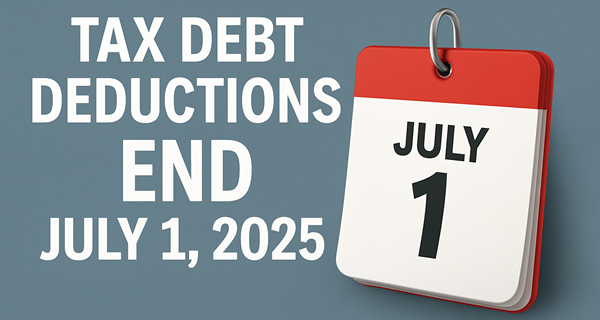A lot of tax debt got accumulated during COVID – and kept accumulating through the post-COVID “holiday” for repayments.
Many SMEs felt like they could leave the issue on the backburner. After all, the interest payments on tax debt were deductible, weren’t they? And who can’t use an extra deduction?
Those tax debt deductions stop in a couple of weeks
Recent legislation changes mean that interest payments on tax debt will not be an allowable deduction as of 1st July 2025. (Even on a payment plan!)
So if you continue to carry a tax debt, you’re going to spend even more time working for the government than you already are.
Every dollar you pay in tax debt interest will come straight off your bottom line AND you’ll still need to pay tax on the money you have to earn to pay that debt off. (Ouch!)
Carrying a Tax Debt of $50,000 could cost a small business as much as $15 per day – off their after-tax income. That would mean they would have to make an extra $150/day if they’re running on a 10% margin. (Double ouch!!)
Is there any upside to this?
While it’s going to be painful, this could also be the push that many SMEs need to face up to the structural industry cash flow issues hiding behind their tax debt.
What turns a predictable tax bill into a terrifying Tax Debt?
Why is it that many SME operators – despite showing a decent profit on their annual tax return – still can’t pay their assessed taxes when they’re due?
The reasons are the same as the reasons that they:
- Scrimp on ordering stock
- Delay supplier payments
- Cut back on vital services
- Stop paying themselves an income AND
- Suffer lots of sleepless nights and stress-filled days
Their underlying problem is the inconsistent cash flow through their business. The root cause of this inconsistency is a fundamental reality of the 21st century that:
The majority of small businesses have to PAY FOR what they need to operate long before they GET PAID.
Retailers have to buy in stock months ahead. Construction companies have to buy materials and pay subbies. Services businesses have to make payroll every fortnight and meet infrastructure costs every month. And most SMEs have to wait 30-90 days to get paid, creating recurring, massive Working Capital Cash Gaps.
Bigger businesses deal with a lack of timely Working Capital by sourcing investor funding.
Most SMEs don’t have access to traditional, external Working Capital sources – so they end up in a spiralling Cash Trap. (One which actually gets worse as they grow!)
That Cash Trap – the lack of available cash in the business WHEN their tax is due – is often what often turns a predictable tax BILL into a costly tax DEBT.
Today the SME Cash Gap has solutions
The good news is that – in 2025 – there are SME cash flow solutions that didn’t exist as little as 10 years ago. The better news is that today’s affordable, tech-enabled tools offer long-term, structural solutions to the Cash Gap which enable you to increase productivity.
Fix your tax debt, increase your productivity AND cut your stress
Depending on your business, your industry and your ambitions, there are a number of affordable, low-overhead Working Capital solutions that can plug your Cash Gap and increase your Cash Availability.
Some examples of today’s SME finance solutions are:
- Debtor Finance – which enables you to access around 80% of the value of your customer invoices when you invoice.
- Trade Finance – which adds weeks of extra time to supplier payment due dates.
- Receivables Management Finance – a unique form of Debtor finance which outsources payment management so you don’t have to play debt collector.
With a customised strategy from an expert Working Capital Strategist, the right Cash Flow finance tools can put your business on the path to increased prosperity.
You won’t just deal with your Tax Debt, you’ll build your business and reduce your stress.
Download my Tax Debt whitepaper today – or book now for your free Working Capital Strategy Review.



